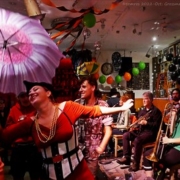Wrapping One’s Head Around Iconic Musical Performances
Last week, while mindlessly scrolling through TikTok, I stumbled upon a clip of singer, songwriter, and jazz bassist Adeline Michèle (aka Adi Oasis), performing a gig wearing a white hotel bathrobe and a towel turban around her head.
Undoubtedly, Adi’s decision to wear the bathrobe and head wrap on stage is one of the most unconventional fashion choices seen in modern musical performances.
Drilling deeper, one might wonder: why didn’t Adi, or one of her bandmates or friends, rush out and buy something more suitable for the occasion?
Also, why not stop at the bathrobe?
But Adi took her wardrobe a step further by sporting a head towel wrap, suggesting she had just stepped out of the shower, a choice that is reminiscent of classic advertising campaigns by Estée Lauder and L’Oréal, which have often featured models in white bathrobes with towel turbans, and iconic images of Marilyn Monroe, Kate Moss, Naomi Campbell, or even Audrey Hepburn in the classic movie, Breakfast at Tiffany’s.
What initially seemed like a pragmatic, but quirky and improvisational response to an airline screwup, could equally be a deliberate artistic statement, blending circumstance with performance and subtle commentary.
Performance Art, Gimmick, Distraction or Social Commentary?
To begin with, the image of Adi performing in a bathrobe and towel wrap creates an unusual, out-of-context, and—for some—arresting visual. It defies expectations, provoking viewers and listeners to ask questions.
This striking image grabs the audience’s attention, challenging conventional assumptions. It forces spectators to ask: Who is this woman playing the bass? What is the story behind this? Why the unconventional attire?
Is Adi pushing boundaries intentionally, or is it to shock viewers for the sake of spectacle? Could she be drawing on a tradition where everyday inconveniences are transformed into art?
If this is just an opportunistic gimmick, does it detract from the music, or does it enhance the overall experience by adding layers of meaning?
Could the white bathrobe and towel turban evolve into her signature style?
The key challenge is ensuring that this visual—the bathrobe, the towel, and its associated symbolism—does not overshadow the music itself.
If this look becomes a regular fixture at every performance, it risks becoming stale, losing the spontaneity and intrigue that made it memorable in the first place.
Will other musicians or creators begin to adopt this style in their own public performances?
As a form of social commentary, Adi’s attire could subtly critique the absurdities of modern travel, where lost luggage, delayed flights, and bizarre security protocols have become common enough to negatively impact musicians’ ability to engage in their craft and get to their gigs with a minimum of hassle.
In a separate post, Adi mentioned how the airline she took to get to the performance prevented her from bringing her bass guitar on the plane (and then ended up losing her luggage). This isn’t a new problem; many musicians have voiced frustration about airlines restricting or damaging their instruments.
Looking deeper, many iconic musicians—from Jimi Hendrix and Lady Gaga to Gene Simmons of KISS, Prince, David Bowie, and Mike Geier as Puddles Pity Party—have made bold visual choices in both their clothing and their performances, cementing their distinctive images.
Conclusion: Navigating the Balance
The challenge for many artists—musician or otherwise—is ensuring that extraneous things (like the choice of clothing they wear at their performances) doesn’t overshadow the merit of their work.
This not an easy task when they have to balance numerous competing obligations.
Adi’s bathrobe/turban wrap might have started as a one-time improvisation, but if it’s repeated or adopted by others, its originality will fade, becoming just another gimmick.
With so many competing pressures, it’s difficult for creators to remain dynamic and authentic.
Kudo’s to Adi for pulling it off.












